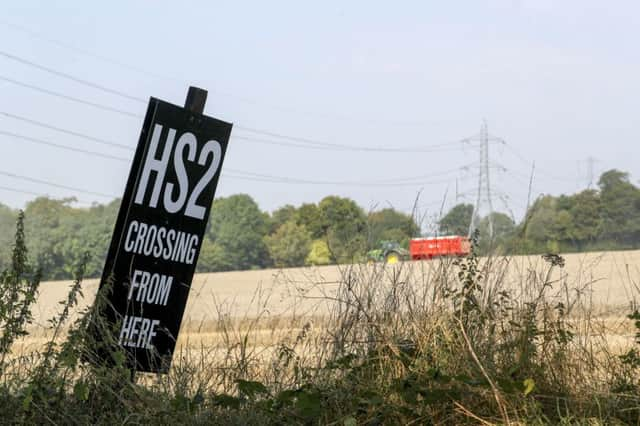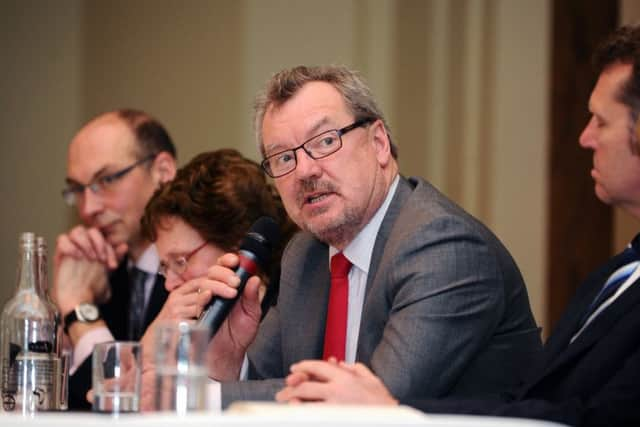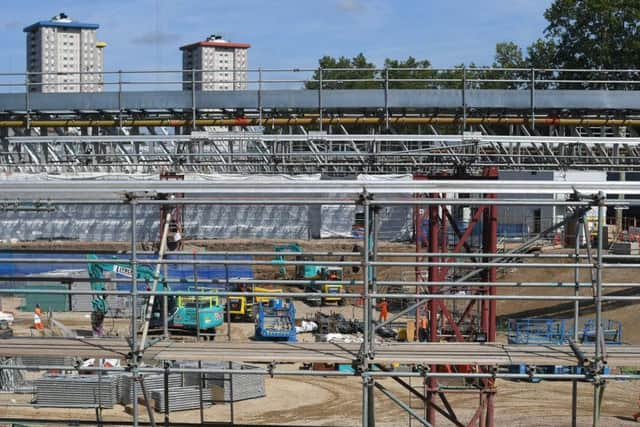Selfishness and shortsightedness of HS2 naysayers must be challenged – Gerald Jennings


The West and North Yorkshire Chamber’s support has been long-standing and is focused on increasing capacity across the rail network, improving connectivity, and better reliability of services.
Advertisement
Hide AdAdvertisement
Hide AdWhy is that? Well more of us than ever are using the railway network in Britain. Demand for rail travel has more than doubled in the past 20 years and passenger numbers continue to grow. Today, our busy and congested rail network serves a complex mix of fast, slow, non-stop and stopping trains. Lots of different trains are competing for a limited amount of space and, as trains can’t overtake on a double-track railway, this leads to unreliability, delays and overcrowding.


Despite a decade of upgrades on the current network, demand is still increasing and even the upgraded sections are running at, or near to, the limits of capacity.
Network Rail invests more than £130 million in improvements for passengers each week – that’s 22 per cent of the UK’s entire infrastructure spend. Over the past 10 years, rail infrastructure investment has amounted to more than £74 billion. Further upgrades to current lines would cause significant disruption for passengers and lineside communities, and would deliver a fraction of the capacity compared to a new railway line.


Advertisement
Hide AdAdvertisement
Hide AdInvestment in HS2 and our rail network is not about building train sets. It’s about facilitating regeneration and enabling social mobility and economic growth. Does anyone seriously believe that a largely Victorian-era built railway network is fit for purpose or can be tweaked to provide a 21st Century network?
No one is asking for a blank cheque and public scrutiny is absolutely correct, but it needs to be balanced. Let’s ensure that while looking at the costs we do not lose sight of the benefits. This should not be about saving money but about investing for the future.
Building HS2 frees up a massive amount of space on the existing railway by placing high speed services on their own pair of tracks. Once HS2 is operating, services can run much closer together and create space for future growth.
HS2 will allow more local, regional and freight trains to operate, including to destinations not served directly by the new tracks. Elsewhere, the alleviation of pressure on key bottlenecks – such as where branch lines meet with long distance routes, or at larger stations – will improve reliability and frequency of services across the UK.
Advertisement
Hide AdAdvertisement
Hide AdThe capacity released by HS2 could more than double evening peak seats between Doncaster and Leeds. Furthermore, as passengers in West Yorkshire and North Yorkshire will have switched to using HS2 services, there will be a substantial increase in seat numbers for passengers who are starting their journey at Huddersfield, Doncaster and Wakefield on the classic network.
Once HS2 Phase 2b is operating, the capacity released could see trains run hourly from Bradford Forster Square to London Kings Cross on the classic network. The alleviation of pressure on key bottlenecks will improve services across the region and this could see the amount of hourly services double between Leeds and eastern towns such as Newark, Grantham and Retford, with direct services to Norwich and Cambridge possible.
But it isn’t just about passengers. HS2 Phase One could take more than 3,600 lorries off UK roads every day between London and the West Midlands, with Phase 2a extending this gain to the North West. As HS2 will take the bulk of the intercity passenger traffic onto the new high-speed line, more freight could be handled on the existing network between London and the West Midlands. This released capacity equates to more than one million lorries that could be taken off the roads every year as a result of HS2 – improving air quality, reducing road congestion and helping the fight against climate change.
This figure will only increase as HS2 expands northwards to Leeds. Capacity released on the East Coast Main Line could be used to serve container freight from East Anglia and the Thames Gateway to Yorkshire and the North East. Rail traffic could better serve deliveries of material to Drax Power Station, close to the East Coast Main Line, which has been converted from coal to biomass as part of the national programme to reduce carbon emissions.
Advertisement
Hide AdAdvertisement
Hide AdWe hear from many who say that east – west connectivity is far more important than faster trains to London. However HS2 is key to the delivering the plans for the Northern Powerhouse Rail (NPR) network, and will provide the backbone on which our NPR ambitions can be realised. Would anyone seriously contemplate the M62 without the M1. No, they obviously wouldn’t. HS2 and NPR must be built as part of a network not as isolated projects and so it is essential that touch points such as those recommended at Stourton and Church Fenton, along with four tracking out from the east of Leeds to the existing East Coast Mainline be built to allow high speed trains to transit through the existing Leeds station and ensure Bradford, York, Sheffield and other northern cities all benefit from increased connectivity.
We also hear that HS2 will drag people and businesses south to the detriment to northern cities; however in recent years we are seeing that exact opposite with organisations choosing to move to locations where they can recruit and invest in northern talent. Recent examples include Channel 4 and Burberry. Whilst London will remain a global city, imagine how powerful a well-connected north and south could be for the UK economy.
Why can’t we be confident that with improved connectivity we can be more attractive as a place in which to live work and play and have investment move north? Perhaps we should close the M1? By way of an example, look at Leeds’s twin city Lille and how it has benefited from high speed rail connections with Paris.
It is not true to say businesses don’t need to physically connect. Modern technology has not replaced the need to meet!
Advertisement
Hide AdAdvertisement
Hide AdWhen I hear naysayers say they’ll be long gone by the time HS2 arrives I like to remind them it’s not just about them. It’s about the next and future generations. Let’s move on from a rather self-absorbed if not selfish attitude of “it’s all about me”. And after all 2030 or 2035 is in fact not that far away. If we don’t start now we’ll never get there!
We want the transformed Leeds HS2 station to be a through station, not a terminus for HS2 as currently planned.
We want services to move seamlessly on to York, the North East and Scotland so we need to use the Oakervee review to press for additional lines to the east of Leeds.
The cost to Yorkshire, the North and the UK of not investing now and significantly in HS2 and the full rail network cannot be underestimated. I truly believe we will live to regret what would be a lost opportunity for generations to come.
Advertisement
Hide AdAdvertisement
Hide AdAs the Convention for the North takes place in Rotherham, we urge the Prime Minister and his cabinet to recognise that a powerful northern economy with 21st Century connectivity is not a zero sum game but will add significantly to UK plc.
Gerald Jennings is chairman of the North and West Yorkshire Chambers of Commerce.